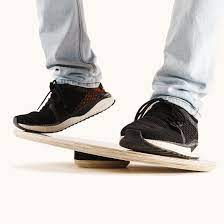|
1. Don't try to stand all day. This is the most important thing. It's not one or the other. Frequent transitions between sitting and standing [and vice versa] are likely to be more sustainable than five hours straight standing. When we sit for long periods, the top half of the body tends to be the focus for pain and discomfort. When we stand [for too long] it's the bottom half — the lower back and the knees. So mixing it up is the way to go. Try first by standing for three minutes, three times an hour, building up to a half-hour sitting and a half-hour standing throughout the day (you can use timers and phone apps as reminders). It's really what works for you. You need to listen to your body and if your colleague can stand an hour at a time but that's tiring for you, you need to pull back a bit. And if you've got an existing injury, you need to be mindful of that. 2. Get your posture right. This means:
3. Move around. The goal is not to stay still like a statue, but rather to incorporate small movements as much as possible. Go up and down on your toes six to eight times and maybe do some shoulder rolls to release any tension. Walk around whenever you can. While leaning to one side for long periods is not recommended, a bit of fidgeting to take continuous pressure of your limbs is good. Another idea is to keep a small platform under the desk where you can rest one leg to take the load off it. Or try a move board. When you stand, you have greater potential to move, as opposed to sitting. 4. Wear the right shoes (or none). Some people find they need different shoes when spending more time on their feet. This might mean they need to wear joggers, or even bare feet. Standing too long in heels for instance can cause women to have problems in their knees, hips and back. Women worried about looking too casual could keep some dressier shoes to slip into for occasions when needed. 5. Consider an anti-fatigue mat. If you're spending a chunk of your day standing, a harder surface underfoot — even carpet over a concrete floor — can become tiring. Standing on an anti-fatigue mat can absorb some of the pressure. 6. Get your ergonomics sorted. Just because you're working upright doesn't mean the normal advice about correct positioning of your computer screen and keyboard go out the window. Whatever your setup, make sure the alignment is still right. If you can transition to standing more gradually and you are aware of the right way to stand, working up to four hours a day on your feet is entirely achievable for most people. At the end of the day, however, not all people like standing up at a desk. The important thing to take from this though is the need to include movement on a regular basis in your day, for your health's sake. So an alternative would be to take regular time out for walks around the office or at home, including stretches. Remember, that as well as maintaining your cardio-vascular health, regular movement throughout the day also helps maintain your muscle health as well, which in turn improves stability, balance and co-ordination. if you have niggling back or neck issues that hinder your ability to stand more or exercise as you would like, then it would be a good idea to see a physio to get things checked out.
Comments are closed.
|
Archives
June 2024
Categories |
|
NorthWest Physio + Kumeu
4B Shamrock Drive Kumeu Auckland |
NorthWest Physio + Whenuapai
87 Brigham Creek Road Whenuapai Auckland |
09 412 2945
[email protected]
www.northwestphysioplus.co.nz
Monday - Friday
Appts from 7am - 6pm
Office hours 8am - 5pm
[email protected]
www.northwestphysioplus.co.nz
Monday - Friday
Appts from 7am - 6pm
Office hours 8am - 5pm
Your local physio, massage and acupuncture therapists who proudly service the North West Auckland community
Kumeu, Riverhead, Huapai, Waimauku, Muriwai, Taupaki, Whenuapai, Woodhill and Massey
Kumeu, Riverhead, Huapai, Waimauku, Muriwai, Taupaki, Whenuapai, Woodhill and Massey




 RSS Feed
RSS Feed